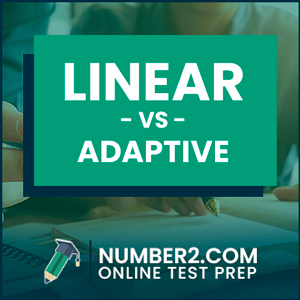 The CPA exam is one of the toughest professional exams in the world. With four different parts totaling 16 hours of exam time, the CPA exam is no joke.
The CPA exam is one of the toughest professional exams in the world. With four different parts totaling 16 hours of exam time, the CPA exam is no joke.
That’s why getting a professional CPA course is so important. There is no way to properly prepare for all of the auditing, taxation, regulatory framework and procedures, management and planning of finances, analytics, and ethics on the exam without one.
In the last few years new learning formats and platforms have been developed by CPA review providers. The two main platforms being adaptive and linear learning:
- Linear or the traditional learning pattern
- Adaptive content software that delivers content to match a student’s specific requirement
Let’s walk through the differences between linear vs adaptive learning CPA courses to understand more about these techniques for preparing for a CPA examination.
What is Linear Learning for the CPA exam?
Think of linear learning as a long followed traditional learning pattern that provides the same course material for all CPA aspirants. It is more like a one-size-fits-all approach where no distinction is made between the student’s skill levels or mental ability. This approach may suit some, but others will remain unimpressed by it.
Linear learning follows the same learning trajectory for all students meaning everyone follows the exact same step to learn from the exact same material. There is step-by-step graduation of a concept until it is fully understood.
Linear learning is called traditional because the education system has employed it for decades. You will begin by learning to write your alphabet, words, and sentences. Or you will discover your numbers, then additions, and then multiplications. It is a step-by-step textbook learning format that has been followed for ages.
Pros Of The Linear Learning Method
Linear learning is an age-old learning format that is still followed because:
- It is easier to apply to large groups of students: Linear learning is best used for large groups of students where it is practically impossible to access an individual’s capabilities. It has worked for the public education system delivering good results.
- It is cost-effective: Individual-based learning will always be less expensive than customized learning methods. This works for cost-sensitive people.
- It is easier to implement: linear learning methods are more focused on the teachers as it is easier for a teacher to implement it in a classroom.
Cons Of The Linear Learning Method
Though the linear learning method has worked for the masses, it is not designed to suit individual needs. The major flaws of this learning format are:
- It does not focus on an individual’s learning capacity: The fundamental flaw of the linear learning method is that it considers all individuals the same. Which we know is never the case. The skills and capacity of each person differ significantly, and using a uniform method for all fails to provide the best benefit to them.
- It is not adaptive: linear learning is not adaptive, which means it will not change as per the requirements of the individual taking the course. The teaching structure and the course material remain the same for all.
Linear learning methods are best suited for the masses.
What is Adaptive Learning for the CPA exam?
Adaptive learning personalizes the non-linear learning approach. The software used for adaptive learning starts by accessing an individual’s knowledge and capacity. It will then tailor the teaching to suit an individual’s personal needs. The instructions will focus on your weak areas and challenging concepts rather than spending time on topics that you understand well.
You cannot say that the best learning technique is moving forward in steps like from alphabets to words to sentences. Think of a child. For example, they may learn to speak much before being introduced to the alphabet—the connection and the correlation that the mind forms do not follow a linear approach.
With time other methods of learning have developed that have given better results. A non-linear way follows teaching more topics together than the step-by-step approach to the subject. The connection and the correlation that the mind develops in this form of learning help better understand the subject.
The adaptive learning software is designed to introduce more topics to you together in a rational manner so that you can form better connections between concepts and, at the same time, find the curriculum interesting. As you continue to use the software, you will find itself adapting to your learning requirements.
Pros Of The Adaptive Or Non-Linear Learning Method
Adaptive learning is the new age learning method that has many advantages:
- It is a more effective learning method: Not all individuals are the same, and neither are their strengths and weaknesses. Adaptive learning focuses on an individual’s weaknesses rather than their strengths. The software also adapts itself to your learning methods, giving you a better result.
- It makes studying more interesting: The software jumps between topics rationally, giving you bite-size models of cases. This makes your connection to the topics better and is also a more exciting approach to learning than the sequential learning order.
- It makes the most efficient use of your time: Since the adaptive learning method focuses on your area of need, it makes better use of your study time. You will not waste time going over topics you understand.
Cons Of The Adaptive Or Non-Linear Learning Method
The non-traditional methods of learning can have disadvantages in a few places. They are:
- It is challenging to use it for the masses: the customized learning format that adaptive learning incorporates is not easily possible to be used for the masses.
- It is more expensive: the adaptive method of learning focuses on an individual’s need which will be more costly to tailor than a same pattern course booklet.
This learning approach is best suited for professional studies like the CPA prep material. It caters to an individual’s learning needs and develops a study plan that can get you through the examination.
Linear vs Adaptive Learning: Time Requirement
A linear study is similar to going through chapters in a book. You will have to spend a lot of time grasping each concept. This will take more of your time than the adaptive learning method.
In the adaptive learning method, the software gauges your skills and knowledge and concentrates on topics that you require to pay more attention to. The information given to you is in bite-sized learning to make better connections between the topics, and it is more interesting for you.
What is the difference between Adaptive and Linear Learning Study Materials?
Linear learning education methods use traditional text books that are studied chronologically, whereas adaptive methods use computer programs to actively create a course as you go through the subjects.
Bottom Line
While the linear study approach has worked for generations, delivering good results, it is not best suited for professional studies like the CPA examination.
CPA examination candidates vary in their skills, qualification, and experience. The personalized study material for their preparation will save them a lot of time and will be more rewarding to them in terms of scores earned.
A CPA course will make you an expert in accountancy and give you access to global career opportunities. With a CPA certification, your scope of work will increase, and you will have an option of practicing accountancy, working with a corporate, or working with an individual entity.

